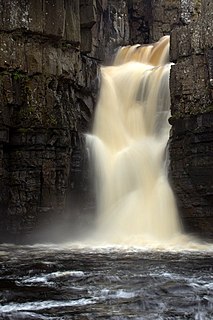
The River Tees, in Northern England, rises on the eastern slope of Cross Fell in the North Pennines and flows eastwards for 85 miles (137 km) to reach the North Sea between Hartlepool and Redcar near Middlesbrough. The modern day history of the river has been tied with the industries on Teesside in its lower reaches, where it has provided the means of import and export of goods to and from the North East England. The need for water further downstream also meant that reservoirs were built in the extreme upper reaches, such as Cow Green.

Hilton is a village and civil parish in the borough of Stockton-on-Tees and the ceremonial county of North Yorkshire, England. It is a small village with an estimated population of around 400, measured at 374 in the 2011 census. Despite its proximity to Teesside, the village retains its rural feel, and has a number of public footpaths surrounding it.
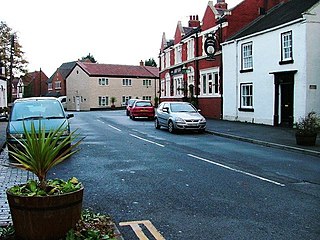
Wolviston is a village and civil parish within the borough of Stockton-on-Tees and the ceremonial county of County Durham, England. The population of the civil parish as of the 2011 census was 877. It is situated to the north of Billingham. The village has several businesses, including a florist, saddlery, international consultancy firm, riding school and post office run by former Middlesbrough footballer Graeme Hedley and his wife. Wolviston benefits from two pubs, the Wellington Inn and the Ship. It has a traditional village green and a duck pond.
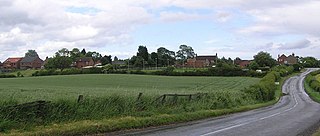
Little Stainton is a village in the borough of Darlington and the ceremonial county of County Durham, England. It is a township in the parish of Bishopton, County Durham, situated a few miles west of Stockton-on-Tees. From the Census 2011 the population of Little Stainton has included that of Great Stainton and was 193. It is a hamlet, consisting of houses and farms that have no local service facilities. On one side of the street, a stream—Bishopton Beck—runs along the bottom of the gardens.
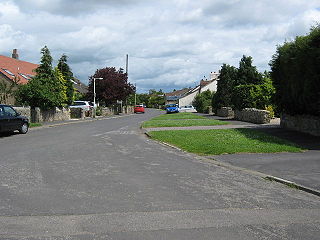
Low Coniscliffe is a village in the civil parish of Low Coniscliffe and Merrybent, in County Durham, England. The population of the civil parish taken at the 2011 Census was 716. It is situated 3 miles (4.8 km) west of Darlington. Its present built-up area is confined in practice between the A1, the A67 and the Tees, but its old boundaries probably extend much further. Its most obvious landmark on the A67 is the Baydale Beck Inn. The village contains a couple of listed buildings and the probable site of a medieval manor house. There was once a gallows in the village. A rare fungus Rhodotus palmatus was found nearby.

Tabley House is an English country house in Tabley Inferior, some 3 kilometres (1.9 mi) to the west of the town of Knutsford, Cheshire. The house is recorded in the National Heritage List for England as a designated Grade I listed building. It was built between 1761 and 1769 for Sir Peter Byrne Leicester, to replace the nearby Tabley Old Hall, and was designed by John Carr.
Middleton One Row is a village in the borough of Darlington and the ceremonial county of County Durham, England. It is situated to the east of Darlington, just north of the River Tees. The village originally consisted of a single row of houses on the north side of the village green, giving the village its name. Medieval villages commonly feature houses on facing sides of the village green but in Middleton One Row the south side of the green drops quickly to the River Tees.

Hurworth Place is a village in County Durham, in England. It lies south of Darlington on the northern bank of the River Tees, opposite the village of Croft-on-Tees in North Yorkshire to which it is linked by Croft Bridge, a Grade I listed structure dating from the 14th century, which marks the county boundary. It is part of the civil parish of Hurworth.

Hurworth-on-Tees is a village in the borough of Darlington, within the ceremonial county of County Durham, England. It is situated in the civil parish of Hurworth. The village lies to the south of Darlington on the River Tees, close to its meeting point with the River Skerne, and immediately adjoins the village of Hurworth Place, which forms part of the same civil parish.

Ormesby is a former village, and now suburb, spanning the Middlesbrough and Redcar and Cleveland unitary authorities in north-east England, within the ceremonial county of North Yorkshire. It forms part of the settlement and built up area of Middlesbrough. The ward, of the same name, has a population of approximately 6,500 residents measured at 5,942 at the 2011 census.

Borough of Darlington is a unitary authority area in the lieutenancy area of County Durham and a part of the Tees Valley region, Northern England. The borough town is Darlington and, in 2011, had a resident population of 106,000.

Croft-on-Tees is a village and civil parish in the Richmondshire district of North Yorkshire, England. It has also been known as Croft Spa, and from which the former Croft Spa railway station took its name. It lies 11 miles (18 km) north-north west of the county town of Northallerton.

Eryholme is a village and civil parish in the district of Richmondshire in North Yorkshire, England. As the population remained less than 100 in the 2011 census, information is included with that of Dalton-on-Tees.

The River Skerne is a tributary of the River Tees. It flows through County Durham in England.
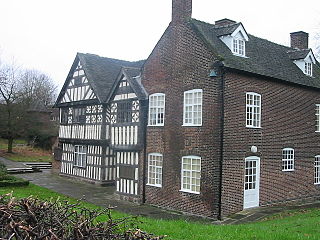
Ford Green Hall is a Grade II* listed farmhouse and historic house museum in Stoke-on-Trent, Staffordshire. The oldest parts of the house date from the late 16th century, with one wing being either added or greatly repaired at some point in the early 18th century. In its grounds, there also stands an 18th-century dovecote which shares the listed building status of the main farmhouse.
Built in 1875, Hurworth Grange Community Centre in the village of Hurworth-on-Tees, Durham, England, has had a long and varied history, from private residence of a wealthy Quaker banking family to its modern-day use as a well-loved community centre. In 2003, a chilling story emerged that the once family Anne and Arthur were found brutally murdered inside the upper floor of the Grange. It is believed foul play was to blame as there were stab wounds to their necks and weirdly, to both of their eyes. The killer, who got the infamous name Eye Ripper, has never been caught and perhaps roams the streets of Hurworth to this day...
Neasham Priory is a priory founded for a community of Benedictine nuns before 1157. Located on the River Tees near Sockburn, County Durham, it was the only such institution in the county to be independent of Durham Cathedral Priory. It was apparently never wealthy or notable.

Matching is a village and civil parish in the Epping Forest district of Essex, England centred in countryside 3 miles (4.8 km) east of Harlow's modern town centre and 2 miles (3.2 km) from Old Harlow/Harlow Mills area of the town. The terrain is elevated and London is centred 21.7 miles (34.9 km) to the southwest.

Ward Jackson Park is a municipal park located in Hartlepool, England. It is named after Ralph Ward Jackson, a local industrialist, who founded West Hartlepool in the 19th century. In later life, Ward Jackson encountered financial difficulties and a fund was established to help him out in his old age. In view of his sudden death, the money collected was used to create a public park.
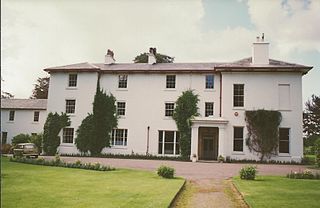
Mere Old Hall is a 17th-century country house which stands to the west of the village of Mere and the junction of the A566 and A50 roads in Cheshire, England.

















